Dark spots and pigmentation can be caused by a variety of factors, including sun damage, acne, and ageing. While there are many different treatments available, chemical peels can be a highly effective option for reducing the appearance of dark spots and uneven pigmentation. In this blog post, we'll explore five ways that chemical peels can help reduce dark spots and pigmentation.
#1 Improving skin texture and tone
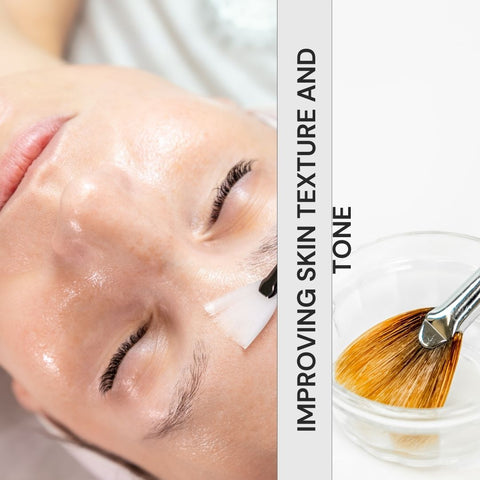
Chemical peels can help improve the overall texture and tone of your skin. They work by removing the top layer of dead skin cells, revealing the smoother, more even-toned skin underneath. This can help reduce the appearance of dark spots and pigmentation, as well as improve the overall health and appearance of your skin. Here are some suggestions to help you achieve smoother, more even skin:
Skincare Routine:
-
Cleansing: Use a gentle cleanser to remove dirt, oil, and makeup without depleting the skin's natural oils. Consider double cleansing, particularly if you use makeup or sunscreen.
-
Exfoliation: Regular exfoliation removes dead skin cells and promotes cell turnover. Use chemical exfoliants (alpha or beta hydroxy acids) or gentle physical exfoliants.
-
Moisturizing: To maintain your skin's moisture balance, apply a suitable moisturiser. Consider using hyaluronic acid-based products to add hydration.
-
Sunscreen: Apply a broad-spectrum sunscreen with at least SPF 30 to your skin daily, even on cloudy days, to protect it from UV rays.
-
Serums: Use serums containing vitamin C, niacinamide, or retinol to address pigmentation and promote collagen production.
Healthy Lifestyle Choices:
-
Hydration: Drink plenty of water to hydrate your skin from the inside out.
-
Nutrition: Consume a nutritious diet high in antioxidants, vitamins, and minerals. Fruits, vegetables, and fatty fish can help improve skin health.
-
Sleep: Aim for 7-9 hours of quality sleep per night to help your skin repair and regenerate.
-
Stress Management: To reduce the effects of stress on your skin, engage in stress-relieving activities such as meditation, yoga, or deep breathing.
-
Avoid Smoking and Limit Alcohol: Smoking and excessive alcohol consumption can negatively affect skin health. Quit smoking and moderate your alcohol consumption.
Before making significant changes to your skincare routine or considering professional treatments, you should consult with a dermatologist to ensure that the approach is appropriate for your skin type and concerns.
#2 Targeting specific areas
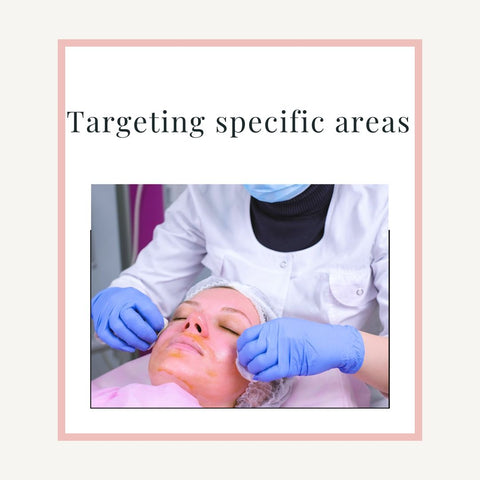
Chemical peels can be customised to target specific areas of the skin. For example, if you have dark spots on your face, your dermatologist may recommend a chemical peel specifically for the face. Or, if you have dark spots on your legs or buttocks, a chemical peel for the body may be more appropriate. This allows for a more targeted approach to treating dark spots and pigmentation.
Here are some tips for addressing specific areas:
-
Dark Spots or Hyperpigmentation: Look for products that contain vitamin C, niacinamide, alpha arbutin, or licorice root extract, as these can help lighten dark spots. Use targeted serums or spot treatments containing these ingredients on the affected areas. Consult a dermatologist for chemical peels or laser treatments specifically designed to address hyperpigmentation.
-
Fine Lines and Wrinkles: Incorporate retinoids into your skincare routine to boost collagen production and reduce the appearance of fine lines. Look for peptide-containing products, as they can also stimulate collagen synthesis. To treat fine lines around the eyes, use specialised eye creams containing ingredients such as hyaluronic acid and peptides.
-
Acne or Acne Scars: Use products containing salicylic acid or benzoyl peroxide to treat acne and prevent breakouts. As previously stated, retinoids can help with skin renewal and may improve the appearance of acne scars with time. Professional treatments such as chemical peels or microneedling can help reduce the appearance of acne scars.
-
Sagging Skin: Vitamin C and E are antioxidants that can help firm and tighten skin. Use retinoids to increase skin elasticity and promote a firmer appearance. These non-invasive or minimally invasive procedures can stimulate collagen production and tighten loose skin.
-
Large Pores: Regular use can help keep pores clear and reduce their appearance. This ingredient can help regulate sebum production, thereby reducing the appearance of large pores. Retinoids can help improve skin texture and reduce pore size.
Individual reactions to skincare products and treatments can vary, so it is important to experiment and seek professional advice to determine what works best for your skin.
#3 Stimulating collagen production
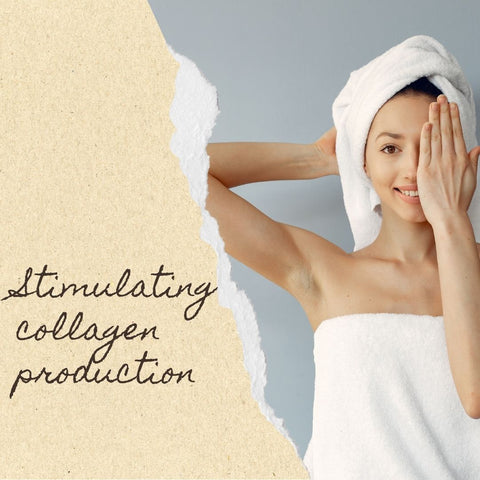
Chemical peels can also help stimulate collagen production in the skin. Collagen is a protein that gives skin its structure and elasticity, and as we age, our bodies produce less of it. By stimulating collagen production, chemical peels can help improve the overall health and appearance of the skin, as well as reduce the appearance of dark spots and pigmentation. Here are some ways to boost collagen production:
-
Topical Retinoids (Retinol): Retinoids, both over-the-counter and prescription-strength, such as tretinoin, have been shown to stimulate collagen production. They also increase cell turnover, which improves the overall texture of the skin.
-
Vitamin C: Vitamin C is an antioxidant that aids collagen synthesis. Look for stable and potent forms of vitamin C in skincare, such as ascorbic acid.
-
Peptides: Peptides are amino acids that can instruct the skin to increase collagen synthesis. Look for skincare products with peptides, particularly those designed to address specific issues such as fine lines and wrinkles.
-
Glycolic Acid and Alpha Hydroxy Acids (AHAs): Alpha hydroxy acids, such as glycolic acid, can help exfoliate the skin, stimulate collagen production, and improve its texture. Incorporate them into your routine by using toners or serums.
-
Microneedling: This technique uses a tool with tiny needles to precisely puncture the skin in small areas. Skin firmness and texture are enhanced as a result of this process, which increases the synthesis of collagen and elastin.
-
Dermarolling: Using a roller with tiny needles, dermarolling—also known as at-home microneedling—is akin to microneedling. It can increase the production of collagen, but you must use it with caution and observe good hygiene.
-
Radiofrequency (RF) Therapy: RF treatments tighten loose or sagging skin by heating the skin and encouraging the production of collagen. RF treatments are provided by professional devices such as Profound and Thermage.
-
Ultrasound Therapy: Ultherapy and other ultrasound treatments use focused ultrasound energy to stimulate collagen production in the skin's deeper layers, resulting in a non-invasive lifting effect.
-
Bone Broth and Collagen Supplements: Consuming collagen-rich foods or supplements may aid in collagen production from within. Bone broth, collagen protein, and some supplements contain the necessary building blocks for collagen synthesis.
-
Sunscreen: Apply a broad-spectrum sunscreen to protect your skin from UV damage. UV rays can degrade collagen fibres, causing premature ageing and loss of skin elasticity.
-
Healthy Lifestyle: A well-balanced diet, regular exercise, and adequate sleep all help to improve skin health and may indirectly support collagen production.
Consult a dermatologist before incorporating new products or treatments into your routine, especially if you plan on having professional procedures done. They can give you personalised advice based on your skin type and specific concerns.
#4 Reducing the appearance of acne scars
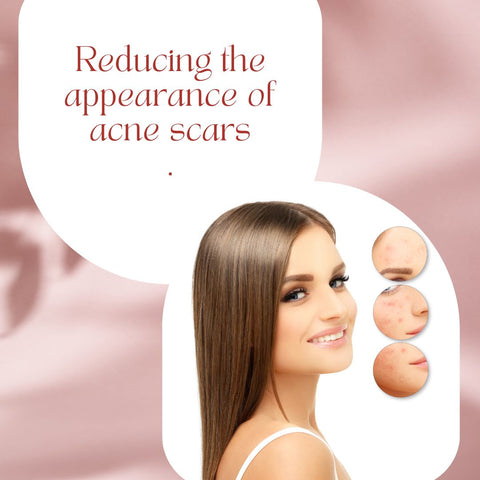
Chemical peels can also be effective in reducing the appearance of acne scars. This is because the peels work to remove the top layer of damaged skin, revealing the smoother, more even-toned skin underneath. Additionally, chemical peels can help stimulate collagen production, which can further improve the appearance of acne scars. Here are some methods you can use to improve the appearance of acne scars:
-
Topical Treatments: Retinoids (Retin-A) can promote cell turnover and stimulate collagen production, thereby improving skin texture. A dermatologist may recommend either over-the-counter retinol products or prescription-strength retinoids. Vitamin C is an antioxidant that promotes collagen synthesis and can help to lighten hyperpigmented skin. Use a stable form of vitamin C in serums and creams. Niacinamide, also known as vitamin B3, can reduce inflammation and improve the overall texture of the skin. It is commonly found in moisturisers and serums. Alpha Hydroxy Acids (AHAs) and Beta Hydroxy Acids (BHAs) are chemical exfoliants that can remove dead skin cells and promote skin renewal. Glycolic acid (AHA) and salicylic acid (BHA) are widely used.
-
Microneedling: Microneedling is a skin treatment that involves carefully causing tiny punctures to the skin, which promotes the production of collagen and helps to minimise the visibility of scars. In addition to in-office procedures, at-home dermarollers with 0.25mm needles are available for modest improvement.
-
Chemical Peels: Using a chemical solution to exfoliate the skin is the process of a chemical peel. They can enhance the general texture of the skin and lessen the visibility of scars. Superficial peels can be done at home, but for deeper peels, professional help is recommended.
-
Laser Therapy: By focusing on the skin's deeper layers, fractional laser treatments help to produce more collagen and lessen the visibility of scars. Depending on how severe the scars are, several laser types, like CO2 or Erbium, may be used.
-
Dermal Fillers: Injectable fillers can be used to fill in depressed scars temporarily. While this doesn't address the scar itself, it can provide a smoother appearance.
-
Silicone-Based Products: Over time, scars can be made softer and more level by applying silicone gels or sheets to the affected areas.
-
Cortisone Injections: These injections can help flatten and reduce inflammation in scars that are raised or inflamed.
-
Sun Protection: Since exposure to the sun can exacerbate the appearance of scars, protecting your skin from UV rays is essential. Every day, apply a broad-spectrum sunscreen with at least 30 SPF.
-
Patience and Consistency: Improving the appearance of acne scars takes time and requires consistency. Be patient and follow your chosen treatment plan.
Before beginning any treatment, consult with a dermatologist to determine the best approach for your particular type of acne scars and skin type. They can make personalised recommendations based on the severity of your scarring and assist you in developing a safe and effective treatment plan.
#5 Enhancing the effects of other treatments
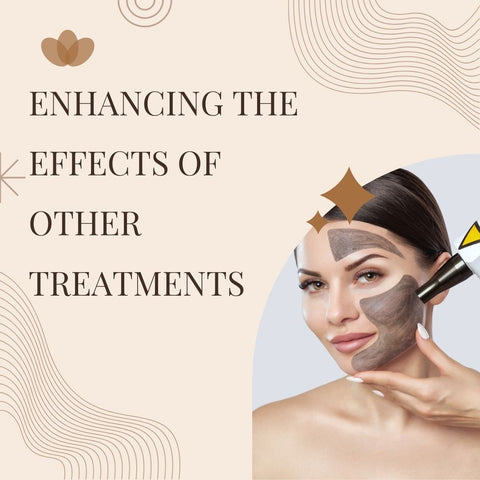
Chemical peels can also be used in conjunction with other treatments to enhance their effects. For example, laser treatment or microdermabrasion may be more effective when used in combination with a chemical peel. Additionally, chemical peels can be used to improve the results of other treatments, such as Botox or fillers. Here are some general tips for increasing the effectiveness of your skincare treatments:
-
Consistent Skincare Routine: Follow the product's or treatment's recommended usage instructions. Patch tests should be performed prior to the introduction of new products to rule out any potential allergies or sensitivities. Apply products in the proper order, typically from thinnest to thickest consistency.
-
Exfoliation: Incorporate gentle exfoliation into your routine to remove dead skin cells and allow other products to penetrate better.
-
Hydration: Apply a suitable moisturiser to keep your skin hydrated. Hydrated skin is more responsive to active ingredients.
-
Sun Protection: Always use sunscreen with at least SPF 30 to protect your skin from UV damage. Sunscreen helps preserve the effects of treatments and prevents further damage.
-
Healthy Lifestyle: A well-balanced diet that is high in antioxidants, vitamins, and minerals will help to improve overall skin health. Drink enough water to keep your skin hydrated from the inside out.
-
Professional Guidance: Seek professional advice to customise your skincare routine for your specific skin type and concerns. If you are undergoing professional treatments, schedule follow-up appointments with your dermatologist to assess your progress and make necessary adjustments.
-
Avoid Irritants: Avoid using products that contain harsh or irritating ingredients, particularly when combining multiple treatments.
-
Patience: Skincare treatments can take some time to produce results. Be patient and consistent in your routine.
-
Consider Boosting Ingredients: Consider adding peptide-containing products, which can help with collagen production and improve the effectiveness of anti-aging treatments. Products containing hyaluronic acid can improve hydration and plumpness.
-
Adjust According to Seasons: Because your skin's needs may change with the seasons, adjust your skincare routine accordingly.
-
Rotate Products: Changing up your skincare products on a regular basis can keep your skin from becoming too accustomed to a particular formula, ensuring that it remains effective.
-
Address Lifestyle Factors: High stress levels can have an impact on your skin. Practice stress-reduction techniques such as meditation or yoga.
-
Monitor Diet and Exercise: Regular exercise can improve blood circulation, resulting in healthier-looking skin. Eating a lot of sugar and processed foods can lead to skin problems.
-
Quality Sleep: Get enough quality sleep, as this is necessary for skin repair and regeneration.
Customise these tips to address your specific skincare concerns and treatments. If you have any adverse reactions or concerns, consult a dermatologist for personalised advice.
Chemical peels side effects
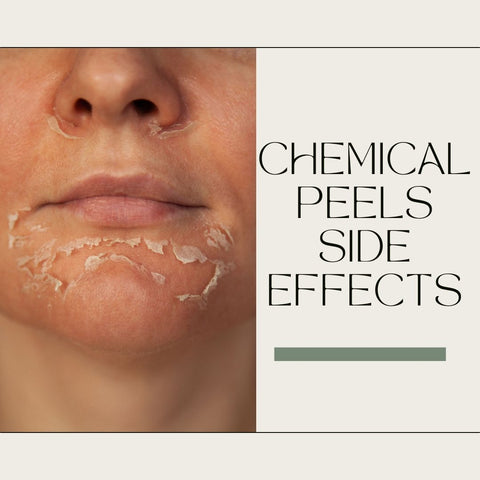
As with any medical treatment, chemical peels do come with some potential side effects. It is important to be aware of these side effects before undergoing a chemical peel, so that you can make an informed decision about whether or not to proceed with the treatment.
Some of the most common side effects of chemical peels include:
-
Redness and swelling of the skin
-
Itching or burning sensations
-
Peeling or flaking of the skin
-
Changes in skin colour, including lightening or darkening of the skin
-
Blisters or scabs on the treated area
-
Scarring or infection in rare cases
It's important to note that these side effects are usually mild and temporary, and will typically subside within a few days to a week after the treatment. Additionally, your dermatologist will provide you with post-treatment care instructions that you should strictly follow to avoid complications.
It's also worth noting that chemical peels can have different side effects depending on the strength of the peel and the area of the skin being treated. For example, a light chemical peel is less likely to cause side effects than a deeper peel. And, chemical peels on the face may have less side effects compared to chemical peels on the body.
It's important to consult with a board-certified dermatologist before undergoing a chemical peel, in order to evaluate whether the treatment is appropriate for you and to discuss any potential risks and side effects. You can now consult dermatologist online from the comfort home and enjoy seamless booking experience and personalized treatment based on your skin type and concern at Clinikally.
Understanding potential risks and precautions
When considering a lip enhancement procedure or treatment, it is critical to understand the potential risks and take appropriate precautions. Here's the breakdown:
Potential Risks:
-
Swelling and bruising: Following a lip enhancement procedure, swelling and bruising are common side effects that typically resolve within a few days. However, excessive swelling or bruising may occur, particularly if procedures are not performed correctly.
-
Infection: Any procedure that breaks the skin increases the risk of infection. Proper sterile techniques and adherence to aftercare instructions are critical for reducing this risk.
-
Allergic Reactions: Some people may be allergic to certain ingredients used in lip enhancement procedures, such as fillers or topical numbing agents.
-
Asymmetry or lumps: In some cases, uneven results or the formation of lumps in the lips may occur. This could happen if the filler is not evenly distributed or migrates after the procedure.
-
Nerve Damage: Injections into the lips can occasionally cause nerve damage, resulting in temporary or, in rare cases, permanent loss of sensation in the lips.
-
Granulomas or Inflammatory Reactions: Certain fillers can cause small, firm nodules known as granulomas to form, resulting in localised inflammation.
Precautions:
-
Research and Choose a Qualified Practitioner: Ensure that the practitioner performing the procedure is qualified, experienced, and certified. Research their credentials, read reviews, and ask for before-and-after photos of their work.
-
Discuss Medical History: Before the procedure, provide your practitioner with your complete medical history, including any allergies or previous adverse treatment reactions.
-
Understand the Procedure: Go over the procedure in detail with your practitioner. Understand the type of filler being used, the expected outcome, and any potential side effects or risks.
-
Follow Aftercare Instructions: Stick to the aftercare instructions provided by your practitioner. This could include avoiding certain activities, using ice packs, or taking prescribed medications to alleviate pain or prevent infection.
-
Start conservatively: Consider using a small amount of filler during the initial procedure to see how your body reacts and how the results look.
-
Report Any Issues: If you experience severe pain, prolonged swelling, or signs of infection following the procedure, contact your practitioner right away.
Always put your safety and well-being first by thoroughly researching and understanding the potential risks of any lip enhancement procedure. Discuss your concerns openly with a qualified practitioner and follow their advice to reduce risks and have a safer experience.
Managing skin sensitivity post-peel
Managing skin sensitivity after a chemical peel is critical to promoting healing and avoiding complications. Here are some tips for managing skin sensitivity after peeling:
-
Follow Aftercare Instructions: Stick to the aftercare regimen suggested by your skincare professional. This may include using specific cleansers and moisturisers, as well as avoiding certain products or activities.
-
Moisturise Frequently: Use a gentle, hydrating, fragrance-free moisturiser on the treated area regularly. This helps to keep the skin hydrated and relieves dryness or irritation.
-
Avoid Sun Exposure: Keep the treated area out of direct sunlight. To prevent UV damage, use broad-spectrum sunscreen with an SPF of 30 or higher and wear protective clothing, hats, or sunglasses when outdoors.
-
Skip Harsh Products: Until your skin has completely healed, avoid using harsh skincare products such as exfoliants, toners, or products containing strong active ingredients such as retinoids or acids.
-
Keep Skin Cool: To calm and soothe the skin, apply cool compresses or gentle mists of thermal spring water. Avoid hot water, steam, and saunas because they can aggravate sensitivity.
-
Hydrate and Nourish: Drink plenty of water to keep your skin hydrated, and consider including antioxidant and vitamin-rich foods in your diet to help with skin healing.
-
Avoid Touching or Picking: To avoid irritation or infection, do not touch or pick the treated area. Allow the skin to heal naturally and without interference.
-
Patience is Key: Be patient during the healing process. Depending on the depth of the peel, your skin may require several days to a few weeks to fully recover.
-
Consult Your Dermatologist: If you are experiencing severe or prolonged redness, swelling, pain, or signs of infection, contact your dermatologist or skincare professional right away for advice and treatment.
Remember that skin sensitivity following a chemical peel is normal and a sign of the healing process. By following proper aftercare instructions and taking steps to soothe and protect your skin, you can help minimise discomfort and promote skin recovery after a peel.
Chemical peel vs Laser treatment
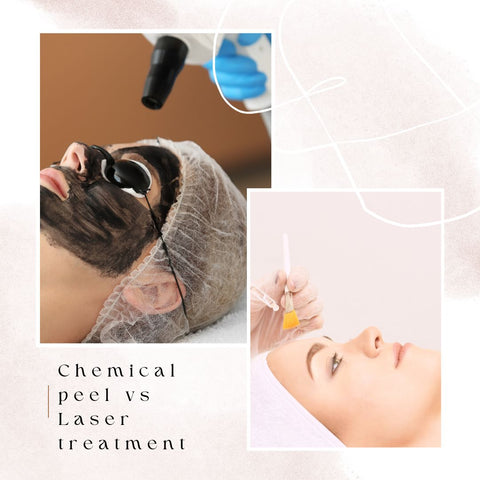
Both chemical peels and laser treatments are popular options for improving the appearance of dark spots and pigmentation. However, the two treatments have some key differences that may make one a better choice for you than the other.
Chemical peels involve the application of a chemical solution to the skin, which causes the top layer of dead skin cells to peel off. This can help to reduce the appearance of dark spots and pigmentation by revealing brighter, smoother skin underneath.
Laser treatments, on the other hand, use a beam of light to target specific areas of the skin. This can help to reduce the appearance of dark spots and pigmentation by breaking down the excess melanin that causes discoloration.
Here are a few key differences between chemical peels and laser treatments:
-
Recovery time: Chemical peels typically require a period of peeling and redness, which can last for several days to a week. Laser treatments, on the other hand, may require a shorter recovery period, but may require more than one session.
-
Cost: Chemical peels tend to be more affordable than laser treatments. But, laser treatment may have better result and long-lasting effects.
-
Effectiveness: Chemical peels can be effective for mild to moderate cases of dark spots and pigmentation. However, laser treatments may be more effective for severe cases or certain types of pigmentation such as melasma.
-
Side effects: Chemical peels may cause redness, peeling, and changes in skin colour. Laser treatments may cause redness, swelling, and changes in skin colour, but these side effects tend to be less severe than those of chemical peels.
It's important to keep in mind that each person's skin is unique, and what works for one person may not work for another. Consulting with a board-certified dermatologist will help you determine which treatment is best for you and your individual needs.
Comparing efficacy and suitability
When comparing the efficacy and suitability of skincare products or treatments, several factors must be considered, including their intended use, ingredients, potential side effects, and individual skin concerns. Here's the breakdown:
Efficacy:
-
Skincare Products: The efficacy of skincare products, such as moisturisers, serums, and exfoliants, varies according to their formulation, active ingredient concentration, and intended application. Look for products that contain clinically proven ingredients to address specific skin concerns such as hydration, acne, ageing, or pigmentation.
-
Treatments (such as Chemical Peels): For certain skin conditions, such as enhancing skin texture, minimising fine lines, or treating hyperpigmentation, cosmetic procedures such as chemical peels provide more precise and fast results. The kind, intensity, and skin reaction of the individual all influence how effective they are.
Suitability:
-
Skincare Products: Individual skin types, concerns, and sensitivities determine which skincare products are appropriate. The suitability of products designed for specific skin conditions (like acne or rosacea) or oily, dry, or sensitive skin may vary amongst individuals.
-
Treatments: Qualified professionals who can evaluate your skin type, concerns, and medical history should administer professional treatments like chemical peels. They can also choose the right type and strength of the peel. Not everyone responds well to peels; those with particular skin issues or sensitivities may need customised care or other options.
Considerations:
-
Ingredients: Consider the components of skincare treatments or products. Seek out components with scientific backing, such as antioxidants, retinoids, alpha hydroxy acids (AHAs), or hyaluronic acid, that are proven to be beneficial in treating particular skin issues.
-
Side effects: While treatments like chemical peels can result in transient redness, peeling, or irritation after the procedure, skincare products may have fewer immediate side effects. It is critical to comprehend the possible adverse effects and recovery period.
-
Long-Term vs. Short-Term Results: While chemical peels and other skincare procedures can sometimes result in a brief period of healing, they can also yield more immediate visible results over time with regular use.
-
Cost and Maintenance: While some treatments may have longer-lasting effects but call for recurring sessions or maintenance, skincare products usually need to be used regularly for maintenance.
The decision between skincare treatments and products ultimately comes down to your personal preferences, financial constraints, and the guidance of skincare experts. Comprehensive skincare results can often be obtained by combining appropriate skincare products for daily use with sporadic professional treatments. The best course of action for your skin concerns and objectives can be determined by speaking with a dermatologist or other skincare specialist.
Personalizing treatment for skin types
Personalising the particular traits, issues, and requirements that are particular to each skin type is necessary to customise treatment for various skin types. For common skin types, treatments can be customised as follows:
-
Normal Skin: For those with regular skin types, staying hydrated and shielding the skin from the elements are usually key components of skin health maintenance. It's imperative to use moisturisers, broad-spectrum sunscreen, and gentle cleansers. Skin equilibrium can be preserved with light treatments like moisturising masks or occasional exfoliation.
-
Dry Skin: Nutrition and moisture are necessary for dry skin. Make use of rich, emollient moisturisers and mild, moisturising cleansers. Treatments with hyaluronic acid, ceramide, or oil can help restore moisture. Steer clear of harsh cosmetics that deplete the skin's natural oils and think about using face oils or moisturising masks occasionally.
-
Oily Skin: Maintaining a balance between excessive oil production and skin peeling is beneficial for oily skin. Use non-comedogenic products and mild, foamy cleaners. Clay masks and salicylic acid treatments can help reduce oiliness, and sporadic exfoliation can help clear clogged pores.
-
Combination Skin: A balanced strategy is needed to treat both oily and dry areas of combination skin. For all regions, use a mild cleanser; for the dry cheeks and oily T-zone, use separate products. Hydrating moisturisers without oil are effective. Combination skin can be balanced with occasional T-zone exfoliation and dry area hydration treatments.
-
Sensitive Skin: To prevent irritation, sensitive skin needs hypoallergenic, soft, and fragrance-free products. Apply gentle, non-irritating moisturisers and cleansers. Steer clear of powerful active chemicals and aggressive exfoliants. Try aloe vera, oatmeal, or chamomile extracts for soothing treatments, or patch test new products.
-
Acne-Prone Skin: Products that manage excess oil, clear pores, and combat acne-causing bacteria without creating irritation are necessary for skin that is prone to acne. Make use of oil-free moisturisers, mild, non-comedogenic cleansers, and treatments with benzoyl peroxide or salicylic acid. Frequent exfoliation and infrequent spot treatments could be advantageous.
-
Aging/Mature Skin: Products that address fine lines, wrinkles, and lack of elasticity are beneficial for ageing skin. Use moisturisers that are moisturising and high in antioxidants, mild cleansers, and treatments that contain hyaluronic acid, retinoids, or peptides. Skin texture and firmness can be improved through frequent exfoliation as well as sporadic treatments such as facial massages or collagen-stimulating procedures.
Customising skin care regimens for distinct skin types entails choosing ingredients and methods that are suited to each skin type's particular requirements and issues. A customised skincare routine that addresses your skin type and issues can be created with the assistance of a dermatologist or other skincare specialist.
5 ways chemical peels can brighten your complexion and say goodbye to dark spots and pigmentation
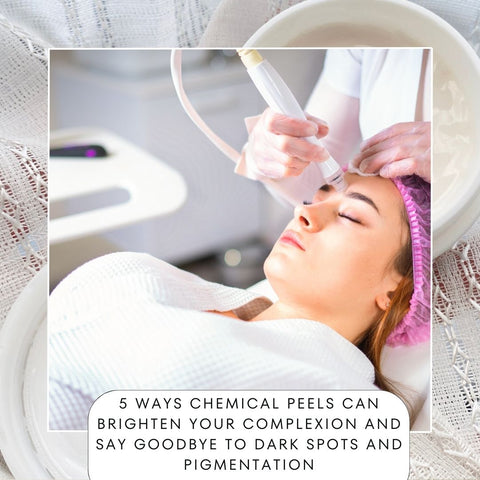
In conclusion, chemical peels can be a highly effective option for reducing the appearance of dark spots and pigmentation. They work by removing the top layer of dead skin cells, revealing the smoother, more even-toned skin underneath. Additionally, chemical peels can help stimulate collagen production, which can improve the overall health and appearance of the skin. It's important to consult with a dermatologist who will recommend the best chemical peel that suits your skin type, and condition and can explain the cost, risks, and benefits before proceeding with the treatment.
Types of chemical peels for hyperpigmentation
Chemical peels are a popular treatment for hyperpigmentation, which is the darkening or discoloration of the skin. Different chemical peels can be used to treat hyperpigmentation depending on its severity, depth, and skin type. Here are common types of chemical peels used to treat hyperpigmentation:
-
Superficial or Light Peels (Glycolic Acid Peel):
-
Purpose: Effective for mild hyperpigmentation and uneven skin tone.
-
Ingredients: Typically consist of alpha hydroxy acids (AHAs), such as glycolic or lactic acid.
-
How They Work: These peels exfoliate the top layer of the skin, encouraging cell turnover and removing superficial pigmentation.
2. Medium Peels (TCA Peel - Trichloroacetic Acid):
-
Purpose: Suitable for moderate hyperpigmentation, such as sunspots or melasma.
-
Ingredients: Contains higher concentrations of trichloroacetic acid (TCA) than light peels.
-
How They Work: They act by penetrating the skin more deeply, stimulating the production of collagen and targeting more pronounced pigmentation.
3. Deep Peels (Phenol Peel):
-
Purpose: Treats severe hyperpigmentation or skin damage.
-
Ingredients: Uses phenol, a potent chemical agent.
-
How They Work: They penetrate deep into the skin to treat pigmentation issues. This type of peel requires careful application and longer recovery time due to its strength.
4. Combination Peels:
-
Purpose: Practitioners may use a combination of acids (e.g., TCA and glycolic acid) to effectively target different skin layers and hyperpigmentation types.
Considerations:
-
Skin Type and Sensitivity: The type and strength of the chemical peel used to treat hyperpigmentation should be based on the individual's skin type, sensitivity, and the severity of pigmentation issues.
-
Professional Advice: Consult a qualified dermatologist or skincare professional to determine the best peel and concentration for your particular type of hyperpigmentation. They can evaluate your skin, recommend an appropriate peel, and ensure that the procedure is carried out safely.
-
Pre- and Post-Peel Care: Following pre-peel instructions and post-peel care, such as using sunscreen, moisturising, and avoiding direct sun exposure, is critical for best results and avoiding complications like post-inflammatory hyperpigmentation.
Chemical peels can effectively improve hyperpigmentation, but their efficacy is dependent on a variety of factors. A personalised approach, guided by a skincare professional, ensures the most effective and safe treatment for your specific hyperpigmentation concerns.
Preparing your skin for a chemical peel
Preparing your skin properly before a chemical peel is critical to achieving the best results and minimising the risk of complications. Here's how to prepare your skin for a chemical peel:
-
Consultation with a Professional: Schedule an appointment with a qualified dermatologist or skincare specialist. They will evaluate your skin type, concerns, and medical history to determine the best peel for your skin.
-
Discontinue Certain Products: At least a week before the peel, stay away from exfoliating products that contain retinoids, beta hydroxy acids (BHAs), alpha hydroxy acids (AHAs), or any other strong or abrasive scrubs. These products have the potential to irritate the skin during a peel by sensitising it.
-
Sun Protection: Protect your skin from sun exposure. To avoid sun damage, use a broad-spectrum sunscreen with an SPF of 30 or higher every day, as sunburned or tanned skin can reduce the effectiveness of the peel and increase the risk of complications.
-
Hydration: Keep your skin hydrated by applying a gentle, non-irritating moisturiser regularly in the days leading up to the peel. Hydrated skin is better able to withstand the peeling process.
-
Avoid Hair Removal: To avoid skin irritation or sensitivity, do not wax, thread, or apply depilatory creams to the treatment area for a week or two before the peel.
-
Notify Your Practitioner: Before the peel, inform your practitioner of any recent changes in your skincare routine, medications, or skin issues you may be experiencing.
-
Follow Pre-Peel Instructions: Your skincare professional may give you pre-peel instructions, like using a gentle cleanser or avoiding certain skincare products. To guarantee the best possible skin preparation, carefully follow these instructions.
-
Skin Sensitivity Test: Before the actual treatment, do a patch test on a small section of the skin using the peel solution, if advised by your practitioner, to check for sensitivity or unfavourable reactions.
By following these pre-peel guidelines, as well as the instructions provided by your skincare professional, you can help prepare your skin for a chemical peel. This preparation phase is critical for reducing potential risks, increasing the peel's effectiveness, and achieving optimal results in improving skin texture and addressing hyperpigmentation or other concerns.
Post-peel care and maintenance
Following a chemical peel, proper post-peel care is essential to aid in the healing process, maximise results, and avoid complications. Here's a guide for after-peel care and maintenance:
-
Follow Professional Guidance: Follow exactly the post-peel instructions provided by your skincare professional or dermatologist. They may provide specific guidelines based on your skin type and the depth of the peel.
-
Moisturise and Hydrate: Use a gentle, non-irritating moisturiser to keep the skin hydrated after peeling. Choose products containing soothing ingredients such as aloe vera or hyaluronic acid to help soothe and restore the skin's moisture barrier.
-
Sun Protection: Protect your skin from sun exposure. Avoid direct sunlight and wear broad-spectrum sunscreen with SPF 30 or higher regularly, even if you are indoors. Sunscreen prevents post-inflammatory hyperpigmentation and protects newly exposed skin layers.
-
Avoid Harsh Products: Avoid using abrasive or exfoliating products, retinoids, AHAs, BHAs, or other harsh ingredients until your skin has completely healed. These can cause additional irritation or sensitization of the skin after peeling.
-
Do Not Pick or Peel Skin: Avoid picking, peeling, or manually exfoliating the skin during the peeling process. Allow the skin to shed naturally and without interference to avoid scarring or complications.
-
Stay Hydrated: Drink plenty of water to keep your skin hydrated and promote healing and renewal.
-
Avoid Makeup and Heavy Skincare: Avoid using makeup or heavy skincare products until your skin has completely healed. During the healing period, keep your skincare routine simple and gentle.
-
Cool compresses or soothing treatments: If your skin is irritated or sensitive, your skincare professional may recommend using cool compresses or soothing treatments to relieve discomfort.
-
Follow-up Appointments: Attend any scheduled follow-up appointments with your skincare specialist. They can evaluate your skin's progress, offer additional advice, and suggest additional treatments or skincare adjustments as needed.
-
Be Patient: Allow time for your skin to heal naturally. Depending on the severity of the peel, your skin may require several days to a few weeks to fully recover. As your skin heals, you may notice improvements in texture or reduced hyperpigmentation.
By carefully following these post-peel care instructions, you can help optimise the results of your chemical peel, reduce the risk of complications, and aid in the skin's healing process for a smoother, more rejuvenated complexion.









































